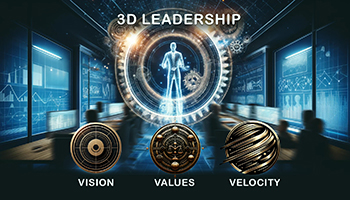
Leadership is an ever-evolving discipline that requires adaptability, strategic thinking, and a deep understanding of three critical dimensions: Vision, Values, and Velocity. Collectively, these elements form what can be termed "3D Leadership". This framework is essential for leaders who aim to navigate today's organizations' complex and dynamic environments. This article explores how integrating vision, values, and velocity can sculpt influential leaders capable of driving significant organizational change and achieving long-term success.
Vision
The first dimension, vision, is the ability of a leader to see the future and articulate a clear path that the organization should follow. It involves understanding the big picture and setting out ambitious yet achievable goals. Visionary leaders inspire and motivate their teams by sharing a clear and compelling future scenario that aligns with personal and organizational objectives.
For instance, Steve Jobs' vision for Apple was not just to create computers but to design innovative and user-friendly technology that enhances people's lives. This clear vision guided Apple through decades of product development and marketing strategies, establishing it as a leader in innovation.
Leaders should engage in strategic planning and trend analysis to develop a strong vision and maintain an open dialogue with stakeholders. Additionally, communicating this vision is crucial. It must resonate with the team and align with its overall strategy.
Values
Values are the ethical foundation of any leadership framework. They dictate the norms and behaviors that are expected within an organization. Leaders who emphasize values foster a culture of integrity and accountability, which are crucial for long-term success.
For example, Satya Nadella's emphasis on "empathy" has been central to revitalizing Microsoft's culture, leading to increased innovation and employee satisfaction. Values like these drive decision-making processes and daily interactions within the company, promoting a positive work environment and better customer relationships.
Leaders can cultivate strong values by embodying them in their actions and decisions and establishing clear policies that reflect these values. This not only helps build a resilient organizational culture but also enhances public trust and corporate reputation.
Velocity
Velocity in leadership refers to the pace at which an organization can adapt to changes and implement decisions to stay ahead in the competitive market. It is about the speed of execution and the ability to mobilize resources effectively to achieve the vision and uphold the values.
Leaders like Jeff Bezos have demonstrated how high velocity can lead to exponential growth in today's fast-paced digital world. Amazon's quick adaptation to market changes and rapid implementation of innovative ideas have been crucial to its success.
Leaders must foster an environment that supports quick decision-making and agile methodologies to achieve high velocity, which involves streamlining processes, encouraging proactive problem-solving, and leveraging technology to enhance efficiency.
Conclusion
The synergy between Vision, Values, and Velocity forms a robust framework for effective leadership. Understanding and integrating these dimensions enables leaders to drive forward with clarity, integrity, and agility. As the business landscape continues to evolve, so too must the practices of leadership. Embracing this 3D approach will equip leaders with the necessary tools to face future challenges and lead their organizations to new heights of success.